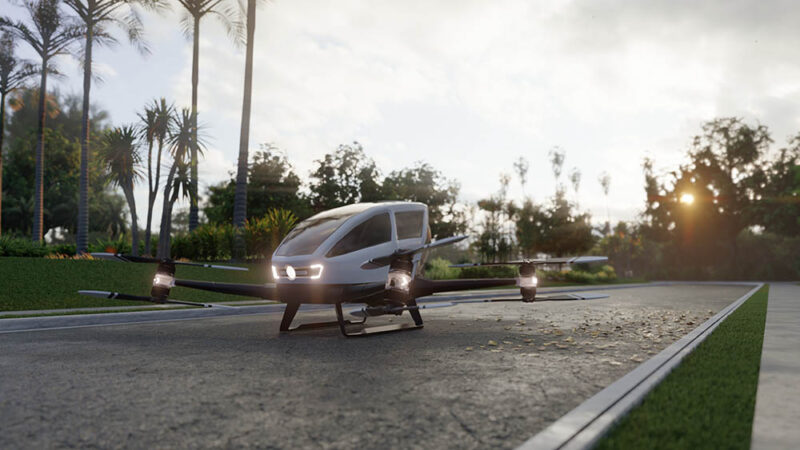Are There Drones You Can Ride?
Last Updated on

Drones are increasingly becoming a popular technology that many individuals and organizations are using. They take amazing aerial photos and videos and can go places that we can’t. But is there such a thing as a drone that can transport humans?
You might be surprised to learn that there is! Move over science fiction and prepare to meet science fact!
If you’re interested in learning more and are even considering picking one up for yourself, here, we discuss these cool human-bearing drones.

The EHang
Chinese company EHang¹ created the EHang 184 AAV (Autonomous Aerial Vehicle) on January 6, 2016. It’s the size of a small smart car and was designed to hold one person up to 260 pounds.
The initial purpose of the EHang was to fly in important customers in order to establish a strong customer base. Today, EHang’s mission is to provide eco-friendly, autonomous, and safe air travel for all in the EHang 216.
It functions like any regular-sized drone and has eight propellers. The flight is preprogrammed, so the passenger can just sit back and enjoy the ride.
It’s designed to maneuver around obstacles like buildings and trees and find a place to land safely. Like a helicopter, it lands and takes off vertically.
The Jetson ONE
The Jetson ONE¹ is a recent addition to the drones-as-a-personal-aircraft family. A Swedish company designed this personal electric aerial vehicle in 2017 and was initially inspired by “Star Wars” in the creation of this drone.
It holds one person at a maximum of 210 pounds and can go up 63 MPH. It’s’ currently selling for $92,000, but all 2022 models are sold out, and the 2023 models are almost sold out too. Since this aircraft is lightweight, you don’t need a pilot’s license to fly it.
More Drones
The DCL Big Drone¹ is designed for racing in the Drone Prix Championships. There’s also the Moog Surefly¹, which had its first test flight in 2018 but isn’t available to the public yet. It almost looks like a small helicopter with four small propellers.
Boeing had its first test flight of its Autonomous Passenger Air Vehicle¹ in 2019, and while it resembles a small airplane, it does have eight small propellers. Two- and four-passenger models are in development.
Astro’s Elroy¹ is designed for two people, and you have the option of flying it manually or autonomously. It can land, take off, and fly responsively all through programming, and you can take over using a touchscreen or joystick at any point while in flight.
The Kittyhawk¹ is similar to the Boeing in that it looks like a small airplane, but like other drones, it can take off and land vertically. It’s single person only and is meant to function as an air taxi, meaning that a ground operator will pilot the Kittyhawk remotely.
The HEXA¹ created by Lift Aircraft has included a ballistic parachute. However, it also has a whopping 18 propellors and can still function when 6 propellers aren’t working. It can also land on both water and land.
In the U.S., there’s the BlackFly¹ by Opener. You can have your name placed on a mailing list to see when one is available for purchase. The cost of one of these aircraft is roughly equivalent to that of an SUV.
Wave of the Future?
Is it possible that one day, personal drones will replace most of our cars? At this point, they are tremendously expensive and in limited quantities. Also, the regulations around the use of this technology are significant biggest impediments.
In the US, the Federal Aviation Administration¹ states that ultralights that are under 254 pounds and cannot fly faster than 63 mph don’t require the operator to have a pilot’s license. This implies that just about anyone can purchase one, but we all can’t suddenly start flying to work every day!
Most of these aircraft don’t have long battery life and can only fly for 20 to 30 minutes. But as battery technology improves, so will the flying time.
So, perhaps all those futuristic movies and cartoons did predict what is yet to happen (especially considering one of these aircraft has been created by a company named Jetson!).

Final Thoughts
There’s no question that these electric vertical take-off and landing vehicles (eVTOL) have many advantages. They are quiet, private, safe, and environmentally friendly. But they are also hard to find and expensive and can’t be used in populated areas — yet.
Many of these companies are also looking at using these vehicles as air taxis. For now, though, anyone who gets their hands on an eVTOL will be just using it for entertainment.
But it is possible that one day, we might be looking at a different world, with everyone flying their own personal aircraft!
Featured Image Credit by: Design Projects, Shutterstock
Table of Contents
About the Author Kathryn Copeland
Kathryn was a librarian in a previous lifetime and is currently a writer about all things birds. When she was a child, thanks to her love of animals she hoped to work in zoos or with wildlife in some way. She's not strong in the sciences, unfortunately, so she uses her time to research and write about all kinds of birds and animals, and hopes to bring that detailed knowledge to OpticsMag.
Related Articles:
Can You Use Binoculars to Look At Stars? How to Choose the Right Pair
How to Clean a Refractor Telescope: Step-by-Step Guide
How to Clean a Telescope Eyepiece: Step-by-Step Guide
How to Clean a Rifle Scope: 8 Expert Tips
Monocular vs Telescope: Differences Explained (With Pictures)
What Is a Monocular Used For? 8 Common Functions
How to Clean a Telescope Mirror: 8 Expert Tips
Brightfield vs Phase Contrast Microscopy: The Differences Explained
